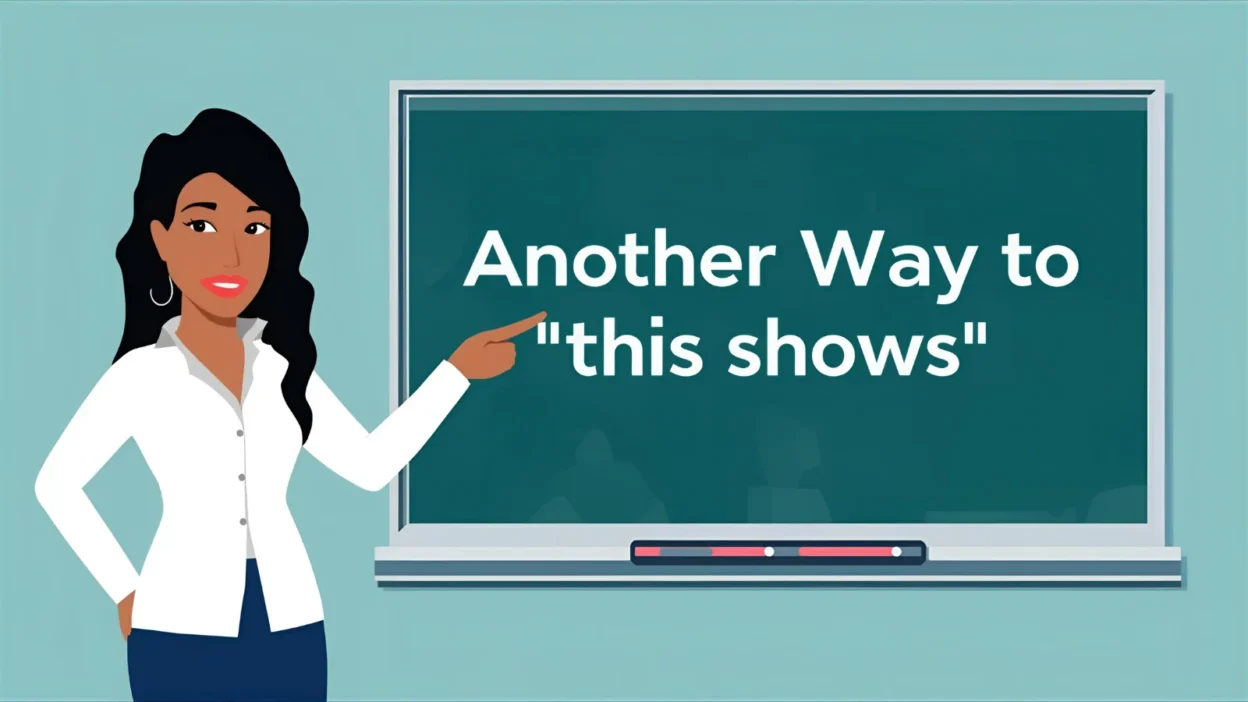The phrase “this shows” is common in essays, reports, presentations, and conversations. It’s often used to explain evidence, highlight proof, or connect an example to a conclusion. However, repeating it too often can make your writing sound repetitive or simplistic. By using alternatives, you can vary your tone, make your analysis sharper, and match the formality of your context—whether academic, professional, or casual.
In this article, you’ll discover 25 smart alternatives to “this shows,” each with a meaning, detailed explanation, usage example, best context, and tone description.
1. This demonstrates
Meaning: Indicates that evidence supports a claim.
Detailed Explanation: Stronger and more formal than this shows.
Scenario Example: The experiment was repeated with consistent results; this demonstrates the reliability of the method.
Best Use: Academic and scientific writing.
Tone: Formal, precise.
2. This illustrates
Meaning: Highlights an example that clarifies a point.
Detailed Explanation: Works well in teaching or explanatory writing.
Scenario Example: The increase in sales illustrates the impact of effective marketing.
Best Use: Explanations, reports, presentations.
Tone: Clear, educational.
3. This indicates
Meaning: Suggests evidence pointing toward a conclusion.
Detailed Explanation: Neutral and analytical, often used in reports.
Scenario Example: The data indicates that customer satisfaction is improving.
Best Use: Business, research, analysis.
Tone: Neutral, factual.
4. This highlights
Meaning: Brings special attention to a point.
Detailed Explanation: Stronger than “shows,” emphasizes importance.
Scenario Example: This highlights the need for better time management.
Best Use: Reports, essays, persuasive writing.
Tone: Emphatic, professional.
5. This proves
Meaning: Suggests undeniable evidence.
Detailed Explanation: More absolute than “shows,” but should be used carefully to avoid exaggeration.
Scenario Example: This proves that teamwork leads to better outcomes.
Best Use: Arguments, debates, strong claims.
Tone: Confident, assertive.
6. This reflects
Meaning: Suggests evidence mirrors a trend or reality.
Detailed Explanation: Softer than proves, focuses on representation.
Scenario Example: The decline in attendance reflects broader student disengagement.
Best Use: Reports, essays, commentary.
Tone: Neutral, thoughtful.
7. This reveals
Meaning: Suggests something previously hidden is made clear.
Detailed Explanation: Adds depth and drama to evidence.
Scenario Example: The study reveals a surprising link between diet and sleep.
Best Use: Academic, journalism, analysis.
Tone: Insightful, formal.
8. This suggests
Meaning: Offers a possibility or interpretation.
Detailed Explanation: Softer, less certain than “shows.”
Scenario Example: The pattern suggests that demand may rise in the summer.
Best Use: Research, analysis, cautious claims.
Tone: Careful, analytical.
9. This emphasizes
Meaning: Stresses the importance of a point.
Detailed Explanation: Stronger than shows, adds weight to the evidence.
Scenario Example: The success emphasizes the value of preparation.
Best Use: Persuasive essays, speeches.
Tone: Strong, assertive.
10. This signals
Meaning: Suggests evidence points toward a development.
Detailed Explanation: Often used in business or trend analysis.
Scenario Example: This signals a shift in consumer behavior.
Best Use: Business reports, commentary.
Tone: Analytical, predictive.
11. This conveys
Meaning: Expresses meaning or message through evidence.
Detailed Explanation: Useful when discussing tone, communication, or ideas.
Scenario Example: Her speech conveys a sense of urgency.
Best Use: Literature analysis, communication studies.
Tone: Interpretive, formal.
12. This supports
Meaning: Provides backing or justification for a claim.
Detailed Explanation: Neutral, used in structured argumentation.
Scenario Example: This supports the argument that early education is essential.
Best Use: Essays, research papers, debates.
Tone: Formal, evidence-based.
13. This points to
Meaning: Directs attention toward a conclusion.
Detailed Explanation: Casual yet effective way of linking evidence.
Scenario Example: This points to the need for reform in the healthcare system.
Best Use: Reports, essays, casual analysis.
Tone: Neutral, accessible.
14. This conveys the idea that
Meaning: Expands on evidence by linking it to an interpretation.
Detailed Explanation: Works well in explanatory writing.
Scenario Example: This conveys the idea that creativity thrives under pressure.
Best Use: Essays, speeches, commentary.
Tone: Thoughtful, explanatory.
15. This makes clear
Meaning: Explicitly clarifies evidence.
Detailed Explanation: Stronger than “shows,” works in teaching or persuasive writing.
Scenario Example: This makes clear the importance of renewable energy.
Best Use: Teaching, arguments.
Tone: Clear, direct.
16. This underlines
Meaning: Reinforces the significance of a point.
Detailed Explanation: Metaphorical and persuasive.
Scenario Example: This underlines the urgency of climate action.
Best Use: Speeches, reports, persuasive writing.
Tone: Emphatic, formal.
17. This depicts
Meaning: Presents something visually or descriptively.
Detailed Explanation: Good for describing charts, imagery, or stories.
Scenario Example: This graph depicts the steady growth of online sales.
Best Use: Reports, presentations, descriptive writing.
Tone: Neutral, descriptive.
18. This exemplifies
Meaning: Provides a typical example of a point.
Detailed Explanation: Polished, academic alternative.
Scenario Example: This exemplifies the challenges of urban planning.
Best Use: Academic writing, formal reports.
Tone: Formal, intellectual.
19. This communicates
Meaning: Suggests evidence expresses meaning.
Detailed Explanation: Close to conveys, often used in literature or design.
Scenario Example: This communicates a sense of calm through minimalism.
Best Use: Art, media, literature analysis.
Tone: Interpretive, reflective.
20. This portrays
Meaning: Shows something in a descriptive way.
Detailed Explanation: Often used for visual or narrative evidence.
Scenario Example: This portrays the struggles of everyday workers.
Best Use: Literature, film, creative analysis.
Tone: Descriptive, formal.
21. This affirms
Meaning: Confirms or validates an idea.
Detailed Explanation: Strong and confident, ideal for persuasive writing.
Scenario Example: This affirms the value of long-term planning.
Best Use: Essays, arguments, debates.
Tone: Assertive, formal.
22. This attests to
Meaning: Provides proof or confirmation.
Detailed Explanation: Formal, legal or academic tone.
Scenario Example: This attests to the durability of the new material.
Best Use: Research, legal writing, formal reports.
Tone: Formal, authoritative.
23. This clarifies
Meaning: Makes something easier to understand.
Detailed Explanation: Great for teaching and simplifying concepts.
Scenario Example: This clarifies the process for new employees.
Best Use: Instructional writing, guides.
Tone: Clear, helpful.
24. This underscores
Meaning: Strongly reinforces a point.
Detailed Explanation: Similar to underlines, but slightly more formal.
Scenario Example: This underscores the importance of consistent training.
Best Use: Academic, professional, persuasive contexts.
Tone: Formal, emphatic.
25. This manifests
Meaning: Suggests something becomes evident or visible.
Detailed Explanation: Poetic or academic choice.
Scenario Example: This manifests in the form of better cooperation among teams.
Best Use: Academic essays, reflective writing.
Tone: Intellectual, formal.
Conclusion
While “this shows” is functional and clear, it can become repetitive and basic when used too often. By choosing alternatives like “this demonstrates,” “this highlights,” or “this underscores,” you can tailor your tone—whether precise, persuasive, or explanatory. These 25 alternatives give you the flexibility to make your writing sharper, more engaging, and more professional.



